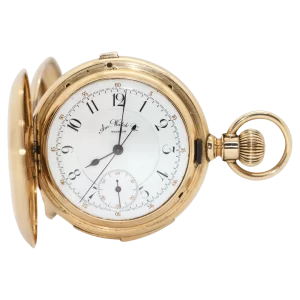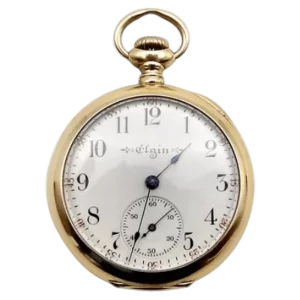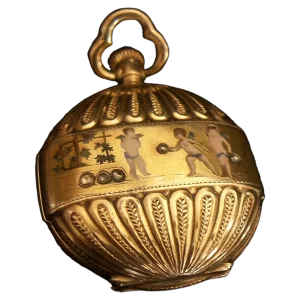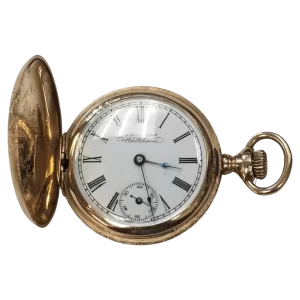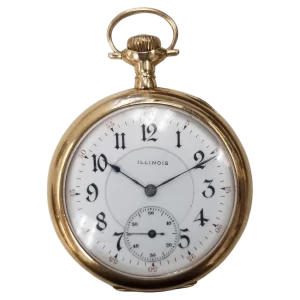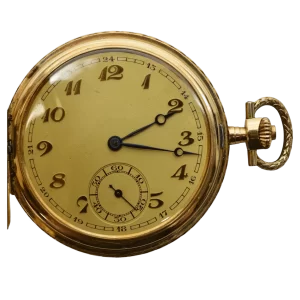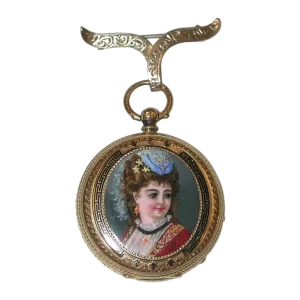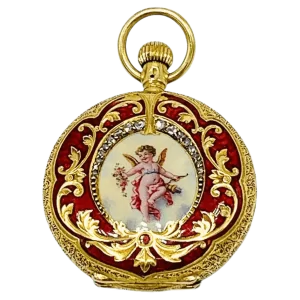The pocket watch, a timeless symbol of elegance and sophistication, has a rich history that speaks volumes about the societal norms and values of bygone eras. These intricate timepieces were more than just functional objects; they were a reflection of a gentleman’s social standing and an heirloom to be cherished across generations. Whether crafted from gold or platinum, or more humble materials like brass or silver, the pocket watch held immense sentimental value, transcending economic divides.
The journey of the pocket watch began in the 16th century with the advent of spring-driven clocks, marking a significant shift from weight-driven mechanisms. Initially, these portable timepieces were cumbersome and often worn as necklaces, but over time, they evolved into the sleek, pocket-sized versions we recognize today. By the 17th century, pocket watches had become more refined and aesthetically pleasing, incorporating intricate designs and advanced mechanisms, including alarms.
The 18th century saw further advancements with the introduction of jeweled bearings and diamond embellishments, elevating the pocket watch to a luxurious status symbol. The precision of these timepieces improved with the addition of second hands and lubrication techniques. The 19th century marked the zenith of pocket watch popularity, with renowned watchmakers like Heuer and Ulysse Nardin gaining fame. Despite the rise of wristwatches in the 20th century, pocket watches remained indispensable in certain fields, such as railroading, where accurate timekeeping was crucial.
Fashion trends have also played a significant role in the popularity of pocket watches. From the extravagant Zoot suits of the 1930s and 40s to the three-piece suits of the 1970s and 80s, pocket watches have made periodic comebacks. While the advent of mobile phones has diminished their everyday use, pocket watches continue to be cherished as retirement gifts and symbols of tradition.
As we delve into the intriguing history of pocket watches, we uncover a tale of innovation, craftsmanship, and enduring legacy that continues to fascinate and inspire.
A pocket watch told society so much about a gentleman, with regard to his social standing and his place in society. Pocket watches were passed down as a family heirloom and something a man could treasure, whether it were made of gold or platinum. Special pockets were made in jackets or vests to accommodate the timepiece. Wealthy men would demonstrate their wealth by the type of pocket watch they owned, generally newly rich could ‘show off’ by the type of pocket watch they had. However social divides did not mean that the poor couldn’t own a pocket watch, in fact they too would have inherited a watch from their father, but the type of metal it was made from could range from brass to silver, but the sentimental value would be priceless.
In the 16th century, clocks were made using springs instead of weight. Portable clocks or pocket watches were the first timepieces that the public could own, but generally it was the rich and was looked upon as a status symbol. Often, portable watches were placed on the wall of the house, but they were not really portable, this idea came some years later. Pocket watches were first produced in the 16th century. This was at the same time as the invention of the spring driven clock. In the beginning, pocket watches were awkward and boxy, and were generally worn as necklaces. Approximately one hundred years later they were carried in the pocket. Development of the pocket watch meant that mechanisms were introduced and some watches even had alarms. The image of the pocket watch began to change in the 17th century. More rounded, slimmer cases were made incorporating designs and generally making the pocket watch a piece of craftsmanship.
In the 18th century jewels were used as bearings and diamonds also became part of some pocket watches, making them very expensive. Oil was used to lubricate and ensure smooth running of the hand movements. Towards the middle of the 16th century second hands ensured accuracy of the time pieces. In the 19th century pocket watches reached the height of their popularity with different watchmakers becoming famous, for example, Heuer, Minerva, LeCoultre & Cie, Ulysse Nardin and many others. During the 20th century, certificates were issued to watchmakers that created precise pocket watches. Prior to the 20th century, pocket watches were the most popular form of personal time keeping. However benefits of wearing a wrist watch soon became apparent during the war when time was needed to be accessed quickly. However pocket watches continued to be widely used in railroading even as their popularity declined elsewhere.
Fashion has dictated when pocket watches became popular. In the 1930’s and 40’s Zoot suits were oversized suits with wide-legged pants gathered at the ankles and a long jacket with huge shoulder pads The excess amounts of fabric made the style a sign of ostentation. The Zoot suit was worn for formal occasions and was often accessorized with a long watch chain on the pants, pointed shoes and a large felt hat with a feather. In the late 1970s and 1980s three piece suits for men were in fashion and this did lead to a small resurgence in pocket watches. In the USA pocket watches were mainly worn in the hip pocket and with the introduction of the mobile phone and its ability to tell the time, the popularity of the pocket watch has slightly diminished. As a tradition in some countries, gold cased pocket watches are given to an employee upon their retirement. Pocket watches and the railroad.
During the last half of the 19th century, the rise of the railroad led to widespread use of pocket watches and keeping accurate time was essential. However, in April 1891 on the Lake Shore and Michigan Southern Railway in Kipton, Ohio a famous train wreck occurred due to an engineers watch stopping for 4 minutes. The railroad officials commissioned Webb C. Ball as their chief time inspector, in order to establish precision standards and a reliable timepiece inspection system for railroad chronometers. This led to the adoption in 1893 of stringent standards for pocket watches used in railroading. These railroad-grade pocket watches, had to meet the General Railroad Timepiece Standards adopted in 1893 by most railroads. — The history of the pocket watch. The first pocket watch was invented by Peter Henlein in 1510 in Nuremberg, Germany. The Italians were producing clocks small enough to be worn on the person by the early 16th century. A pocket watch became a symbol of wealth and status even though the watches of the 16th and 17th century were not terribly reliable but were beautiful ornaments! Cases and dials were painstakingly hand crafted with opulent French designs whilst English, German and Dutch designs were more sedate. As technical advances were made, designs simplified and the watch’s image changed from an unreliable, to a reliable time keeper. In the 18th century, pocket watches continued to evolve. Jewels were used as bearings, sometimes diamonds, but as you can imagine, this made the pocket watch very expensive. Oil was used to lubricate and make the movement smooth. In the second half of the 18th century, pocket watches were produced with three hands, thus making telling the time even more accurate. During the 1st world war, wrist watches were preferred as they were easier to wear however, the pocket watch was still worn with the 3 piece suit in the 1950’s. Up until the middle of the 19th century, watches were individually made and were costly then eventually, with American developments in mechanized watch production, the price of a pocket watch would become cheaper.





